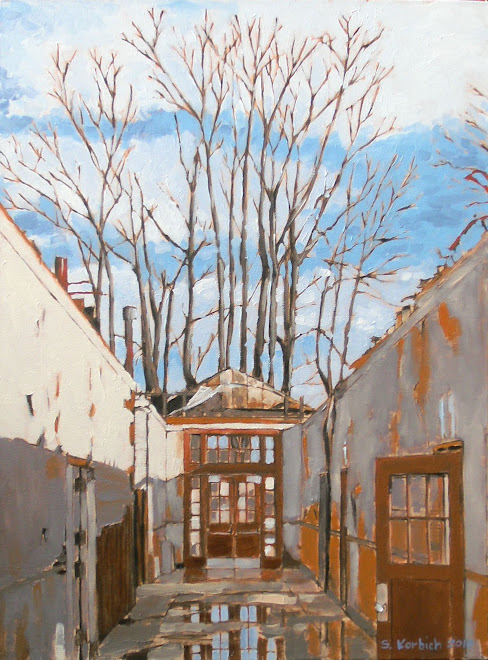They also consider them to be smelly.
Ok, oil paints can be all of these things, but are not necessarily any worse than acrylics.
Brushes:
I use what are called "Brights" which have a straight, flat bristle. I rarely use any rounds or beveled brushes. The brights can be used to make thick or thin strokes.
The smaller four here are what I generally use to do my painting, with the larger one being used for prepping backgrounds.
I don't have a favorite brand per say, I usually look for a good brush that is on sale.
I like the synthetics vs. the horse hair brushes because fo their uniformity and soft feel.

Paint:
I use walnut oil based paints by M. Gharam exclusively. My palette is currently what you see below.
Titanium White
Transparent Iron Ixide, dark and light
Van Dyke Brown
Yellow Ochre
Cerulean Blue
Ultramarine Violet
Ultramarine Blue
Cadmium Red, Light
Quinacridone Red
Olive Green
Cadmium Yellow

Solvents:
These are the things that have more toxic vapors. Thinners are used to make paints more runny and for cleaning brushes. I use a low odor type of mineral spirit, which helps make it easier to live with.
Medium is used to make the paint more fluid and hastens the drying time. This has an alkyd that is kind of nasty. I usually mix a little of the medium with my paint as I mix on the palette using the squeeze bottle you see here.
I keep a little walnut oil to use as a thinner as well. You could use the oil almost exclusively as a medium and to clean things. This would make it much less toxic.
I must stress that even though there are these so called "odorless" thinners, you need to always paint in a well ventilated space. I always have a fan going to move nasty vapors out of the room.
Even still, I need to take a break every hour or so to get some fresh air.
I wish that I could afford to build the studio in my backyard so that I would have more room and better ventilation.

I will have to talk about how I clean my brushes sometime.
Actually, I destroy my brushes, and just happen to run them under water and rub soap into them, which while necessary, seems futile.
Waste:
While taking a painting class I learned that you never have to trash your used thinner. Simply pour the dirty thinner into a mason jar, cover and wait a few days. The solids settle down to the bottom of the jar, leaving virtually clear thinner that you can reuse.
I have a mason jar that I have been using this way for two years now and it is just now getting to the top with sediments.
I have an old board that I wipe all my unused paint on. (it is always a challenge to waste as little paint as possible). This board must weight five pounds by now and I intend to keep piling on the paint. In contrast to acrylic paints, which "clean up" with water, there is little waste added to the water system.
I try to use old underwear and socks for rags. Old under shirts are the best. Once they are nice and dirty, I do need to dispose of them inthe trash. I probably use my rags for vehicle and household projects than I do for painting, which is sad.
I'm going to go out on a limb and say that oil painting is the greener alternative.

No comments:
Post a Comment